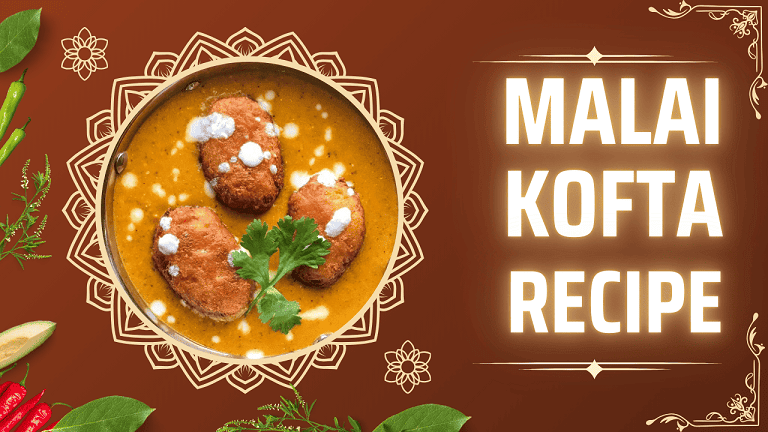Malai Kofta Recipe
Malai Kofta is a beloved vegetarian dish that originates from the royal kitchens of North India, offering a rich blend of flavors and textures.
Traditionally served during special occasions and festivals, it has become a staple in Indian restaurants and households alike.
Kofta refers to spiced dumplings, and in this vegetarian version, they are typically made with a base of mashed potatoes and paneer (Indian cottage cheese). These koftas are then simmered in a creamy, mildly spiced tomato-based gravy.
Apart from its indulgent taste, Malai Kofta can also be highly nutritious. By incorporating fresh, locally sourced vegetables and avoiding heavy creams or deep frying, this dish can be lightened while still preserving its essence.
Paneer provides a good source of protein, and the vegetables contribute essential vitamins and minerals. The key to maximizing both flavor and nutrition lies in using the freshest ingredients and employing thoughtful preparation techniques.
Ingredients
For the Kofta (Dumplings)
- 200g paneer (Indian cottage cheese), crumbled
- 2 medium potatoes, boiled and mashed
- 2 tablespoons grated carrot
- 2 tablespoons grated beetroot
- 1 tablespoon chopped coriander leaves
- 2 tablespoons cornflour or gram flour (besan)
- 1 green chili, finely chopped
- 1 teaspoon ginger paste
- 1/2 teaspoon garam masala
- 1/2 teaspoon ground cumin
- Salt to taste
- 1/4 cup cashews or raisins (optional for stuffing)
- Oil for shallow frying (substitute with air frying for a healthier option)
For the Gravy
- 2 large tomatoes, pureed
- 1 medium onion, finely chopped
- 1 tablespoon ginger-garlic paste
- 1/4 cup cashews, soaked in warm water for 15 minutes
- 1 teaspoon cumin seeds
- 1 bay leaf
- 1-inch cinnamon stick
- 3-4 green cardamoms
- 2-3 cloves
- 1 teaspoon turmeric powder
- 1 teaspoon coriander powder
- 1 teaspoon Kashmiri red chili powder (for color and mild heat)
- 1/2 teaspoon garam masala
- 1/4 cup fresh cream (substitute with cashew cream or coconut cream for a vegan version)
- 2 tablespoons oil or ghee
- 1 tablespoon kasuri methi (dried fenugreek leaves)
- Salt to taste
- Fresh coriander leaves for garnish
Instructions
Preparing the Kofta (Dumplings)
Mixing the Kofta Base
In a large mixing bowl, combine the crumbled paneer, mashed potatoes, grated carrot, beetroot, chopped green chili, ginger paste, garam masala, cumin, and salt. The vegetables not only add a subtle sweetness and nutrition but also lend color to the koftas, making them visually appealing.
Add the cornflour or gram flour to the mixture. This will help bind the ingredients together. Mix everything thoroughly to form a smooth dough.
Shaping the Koftas
Divide the mixture into small portions, about the size of a lime. If you want to add a surprise element, place a cashew or raisin in the center of each portion before rolling it into a smooth ball.
Cooking the Koftas
Heat oil in a pan for shallow frying. If you’re aiming for a healthier version, you can use minimal oil or even air fry the koftas. Fry the koftas until they are golden brown on all sides. Drain them on paper towels to remove excess oil.
Tip: To make the koftas lighter and avoid soaking up too much oil, ensure that the oil is hot enough before frying. You can test this by dropping a small piece of dough into the oil—if it rises immediately, the oil is ready.
Preparing the Gravy
Make the Cashew Paste
Blend the soaked cashews with a little water to form a smooth paste. This will give the gravy its creamy texture without the need for excessive cream or dairy products.
Cooking the Aromatics
Heat oil or ghee in a large pan. Add the cumin seeds, bay leaf, cinnamon stick, cardamom, and cloves. Sauté until the spices release their aroma.
Add the finely chopped onions and sauté until they turn golden brown. Stir in the ginger-garlic paste and cook for another 1-2 minutes, until the raw smell disappears.
Building the Gravy
Add the pureed tomatoes and cook until the oil begins to separate from the tomato mixture. This step ensures that the rawness of the tomatoes is cooked out, creating a well-rounded flavor.
Stir in the turmeric powder, coriander powder, Kashmiri red chili powder, and salt. Cook for another 5 minutes, allowing the spices to meld with the tomato base.
Add the cashew paste and mix well. Let the gravy simmer for 5-7 minutes until it thickens.
Cream and Final Seasoning
Stir in the fresh cream (or cashew/coconut cream for a vegan option). Adjust the thickness of the gravy by adding water as needed.
Crush the kasuri methi between your palms and sprinkle it into the gravy. This adds a subtle earthy flavor to the dish.
Finally, add the garam masala and give the gravy a good stir. Simmer for another 2 minutes.
Assembling the Dish
Once the gravy is ready, gently place the fried or air-fried koftas into the gravy. Let them simmer for 2-3 minutes to absorb the flavors of the sauce.
Tip: Add the koftas to the gravy just before serving to prevent them from becoming too soft and falling apart.
Variations and Substitutions
Vegan Version
Substitute paneer with firm tofu, and replace fresh cream with cashew cream or coconut cream. For binding, you can use chickpea flour instead of cornflour.
Healthier Koftas
Instead of frying the koftas, bake them in the oven at 180°C (350°F) for 20-25 minutes or until golden. You can also air-fry them for a low-oil option.
Keto-Friendly Version
Swap the potatoes with cauliflower or mashed spinach to reduce the carbohydrate content. You can also add almond flour instead of cornflour for binding.
Nut-Free Gravy
If you are allergic to nuts, you can use sunflower seed paste or simply increase the amount of cream to get the desired richness.
Tips for Maximizing Flavor and Nutrition
Use Fresh and Seasonal Ingredients
The quality of the paneer and vegetables will significantly impact the flavor of this dish. Choose fresh, locally sourced produce whenever possible. Seasonal vegetables, such as carrots and beetroots, add a sweet flavor profile, while leafy greens like spinach can provide a nutritional boost.
Optimize Cooking Techniques
Light frying or air-frying the koftas retains their texture while using less oil. The vegetables in the kofta also need minimal cooking to preserve their vitamins and minerals.
Balance Spices and Creaminess
Ensure that the spices are well-cooked, especially the tomato base, to avoid any raw taste. The balance between the creamy koftas and the mildly spiced gravy is key to the dish’s appeal.
Serving Suggestions
Malai Kofta is best enjoyed with soft Indian flatbreads like naan or tandoori roti, as well as steamed basmati rice or jeera rice. For a complete meal, pair it with a light side dish such as a fresh cucumber raita or a salad made with seasonal greens and lemon dressing. Garnish with freshly chopped coriander leaves and a drizzle of cream for an extra touch of elegance.
Presentation Tips
Place the koftas neatly in the center of a wide serving bowl and pour the gravy around them. Garnish with a swirl of cream, a sprinkle of kasuri methi, and finely chopped coriander leaves.
Serve in traditional copper or brass dishes for an authentic touch, or use modern ceramic plates for a contemporary presentation.
For a festive occasion, decorate the edges of the plate with edible flowers or slices of fresh vegetables for a pop of color.
Final Opinion
Malai Kofta is a perfect example of how traditional Indian cuisine can be adapted to suit modern health-conscious lifestyles without compromising on flavor.
By using fresh ingredients and smart cooking techniques, this rich and flavorful dish can be made lighter and more nutritious. Whether served for a special family meal or a festive gathering, Malai Kofta will undoubtedly leave a lasting impression.
Thanks for visiting Veg Recipe

